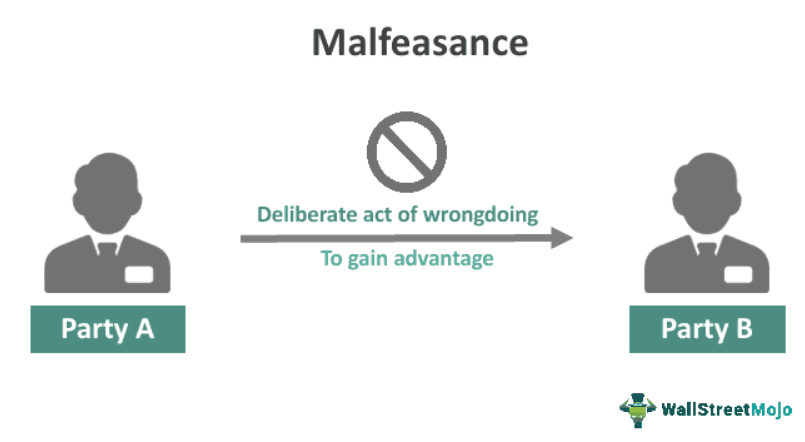Table Of Contents
Malfeasance Meaning
Malfeasance refers to wrongful or illegal conduct, typically by a person in a position of authority or trust. It implies the deliberate intention to commit wrongdoing or harm, often involving actions that violate laws, regulations, or ethical standards.

When individuals in positions of authority or responsibility engage in malfeasance, it can lead to a breakdown of confidence, erode credibility, and result in negative consequences such as financial loss, harm to individuals or communities, and damage to reputation.
Key Takeaways
- Malfeasance refers to unlawful, wrongful, or deceitful actions committed intentionally by people who enjoy a position of authority or power.
- They intend to cause harm, deceive people or systems, or enjoy unfair advantages at the cost of others.
- It involves undertaking activities and initiating actions that go against the law, rules & regulations, or ethical standards, demonstrating a planned, deliberate effort to commit wrongdoing.
- Malfeasance involves intentionally committing unlawful acts, while misfeasance involves making mistakes or errors while performing a lawful act.
- Nonfeasance refers to the failure to fulfill a duty or obligation a person is legally bound to perform.
Malfeasance Explained
Malfeasance in the corporate world refers to a range of unethical or illegal activities perpetrated by executives, officers, or key employees of a company. These activities can vary in scale, from minor offenses to major crimes, and can encompass actions that intentionally harm the company, its stakeholders, or the general public. Some examples of corporate malfeasance include embezzlement, fraud, insider trading, bribery, and accounting irregularities.
Intentional acts that harm the corporation might involve executives making decisions for personal gain that undermine the company's financial stability or reputation. On the other hand, failure to perform duties or adhere to laws could encompass instances where company leaders neglect their responsibilities to ensure compliance with regulations, leading to legal violations or ethical breaches.
The repercussions of corporate malfeasance can extend beyond the company in question. In cases where such misconduct becomes widespread within an industry, it can erode public trust in that sector as a whole. Additionally, when key players in the economy engage in malfeasance, it can have a domino effect, contributing to economic instability and impacting investors, employees, and consumers negatively.
Cases of malfeasance are typically seen in corporations, stock markets, educational institutions, law enforcement departments, etc. At a micro level, it can even occur between two individuals or entities. Strengthening malfeasance laws is a worthy goal many governments pursue to improve the general conditions in a country with respect to its corporate ecosystem, educational landscape, etc.
Examples
Let us look at some examples to understand the concept better.
Example #1
Imagine a scenario where the CEO of a pharmaceutical company instructs the research and development team to intentionally manipulate the data from clinical trials for a new drug. The CEO is aware that the drug's actual effectiveness and safety profile are not as promising as presented in the manipulated data. The CEO's motive is to boost the company's stock value and secure personal financial gains by attracting investors based on the fabricated positive results.
This example illustrates malfeasance through intentional actions that harm the corporation and its stakeholders. The CEO's decision to manipulate data goes against ethical and legal standards, misleads investors, and compromises patient safety. Such actions can have severe consequences for the company, taint its reputation, and belittle the trust of investors and the public. It also highlights the importance of transparency, ethical decision-making, and regulatory compliance within corporations.
Example #2
The case pertains to allegations of bribery and corruption involving a multinational technology company, Cognizant. In the context of corporate malfeasance, the US Securities & Exchange Commission (SEC) press release (from 2019) highlights the actions initiated by the Department of Justice (DOJ) to address corporate crimes. Allegations of payments (bribes) made to secure permits for a corporate campus in India have been covered in this 2019 SEC press release. Cognizant faced accusations of failing to prevent bribery and corruption. This highlights issues related to corporate governance, compliance, and ethics.
The DOJ's policies are part of efforts initiated to hold corporations accountable for misconduct, even if committed by employees. It emphasizes why cooperating with authorities during investigations is crucial. The continued enforcement of these policies despite legal challenges underscores the DOJ’s continued commitment to combating malfeasance in the US.
Malfeasance vs Misfeasance vs Nonfeasance
The differences between malfeasance, misfeasance, and nonfeasance have been discussed in the table below.
| Basis | Malfeasance | Misfeasance | Nonfeasance |
|---|---|---|---|
| Meaning | Malfeasance refers to intentionally committing an unlawful or wrongful act. It involves actively engaging in actions against the law, regulations, or ethical standards. | Misfeasance refers to the improper or negligent performance of a lawful act. It occurs when an individual or entity undertakes legal action but does so in a careless or mistaken manner, resulting in negative consequences or harm to the other party. | Nonfeasance refers to the failure to perform a duty or obligation one is legally or morally responsible for. It involves inaction or neglecting to take necessary action, resulting in harm or negative consequences. |
| Scope of Wrongdoing | Malfeasance implies deliberate wrongdoing with the intent to cause harm or gain an unfair advantage. The intent to harm is clear and well-planned. | Misfeasance involves errors, omissions, or inadequate execution of duties, which may lead to unintended harm. The intent to harm may not be deliberate. | Nonfeasance can occur when an individual or entity fails to fulfill a duty, such as a public official failing to respond to an emergency or a company neglecting its duty to provide essential services. This refers to the failure to deliver per legal terms, irrespective of intent. |

